One vegetable which I really, really, REALLY love is Butternut Squash. Actually I quite like any Winter squash, but I love butternut squash most of all. Kind of funny really because when I was growing up my mom couldn't get me to touch squash with a ten foot pole, and now it is one of my favourite things!
Butternut Squash is sometimes known in Australia and New Zealand as butternut pumpkin or gramma. It is a type of winter squash that grows on a vine, with a sweet, nutty taste which is quite similar to that of a pumpkin. It has tan-yellow skin and orange fleshy pulp with a compartment of seeds in the bottom. I always
Its a pretty essential ingredient for autumn dishes and a must for the holiday table. It’s a big player in comforting soups, stews and sautes, but finding the right one can sometimes be difficult. If it’s underripe, the squash won’t have developed its signature taste. If it’s overripe, it may be dry, mushy or flavorless. Follow these tips the next time you’re at the grocery store or farm market to find the perfect recipe-ready butternut squash.
First pick it up to feel its weight. A ripe butternut squash should be hard and heavy for its size. Use your own judgement and pick up other squashes to get an idea of the average weight. If a squash is too light, it’s not ripe enough yet. You can also do the tried-and-true knocking test. Tap the outside of the vegetable. If it sounds hollow, it’s ready to eat. I also like to pick squashed that have large thick tops or "Necks", necks that are almost the same size as the bulbous bottoms. You get much more squash for your money. The bottom is mostly seeds, so most of the flesh will be in the upper part of the squash. If you get one with a tiny neck, you are really missing out!!
Examine the skin colour The deeper the hue, the better. A butternut squash should be dark beige. Green spots or streaks mean the squash isn’t fully ripened. Look for one with a matte finish, with colour that’s even across the entire surface. The thickness of the shell is also important. Use your fingernail to try to gently prick the surface. If your nail goes through easily, it’s not a good squash. You want one with a really hard exterior.
Stay away from any squash with obvious cuts, gashes, or soft spots that might lead to rot or mold. Brown marks, usually caused by frost, are a sign the squash won’t last as long or will have an undesirable texture.
The skin on the butternut squash is very tough and it can be somewhat difficult to cut. If you want, you can
pop it in the microwave before you start preparing it for a couple of minutes which will help to
make it softer and easier to remove. If you are slow roasting
the squash, you can just leave the skin on as it is quite edible and gets softer
when baked.
How to cut and peel your squash
Hold the squash steady on your chopping board and use a sharp knife
to trim off the top and bottom.
This will make it easier to stand still. Once you have done that, split the squash in half at the point where the long “neck”
section meets the round base section.
If you want to remove the skin you can either use a Y shaped or
swivel blade vegetable peeler or a knife.
Once the skin has been removed, cut the base section in half to
expose the seeds. Scoop them out using a spoon, and discard. Now you can slice the prepared butternut squash into wedges, chunks
or small cubes, depending on what you plan on doing with it.
For this dish, I peeled the squash and cut it into wedge sized pieces, each about 1 inch thick. These were tossed in a bowl along with some olive oil and maple syrup, along with some salt and pepper for seasoning.
You place them onto a lined baking tray that you have sprayed with a non-stick cooking spray. Its important that you line the tray unless you want a stuck on mess to clean up.
This then gets roasted in a moderate oven until the pieces of squash are fork tender and just beginning to caramelise a bit. You don't want them to get too dark, or burnt, but the roasting really helps bring out the natural sweetness, and also helps to keep the vegetable dry. Cook squash can often be very damp, even too damp, if you boil or steam it.
Oh yes, I also added a few sprigs of thyme to further flavour the squash while it is roasting.
Once its all tender you just tip it into a bowl and mash it until it is fairly smooth along with some butter. You decide how much.
You will want to taste it and see if you need any more salt and pepper. And if you need or want any more maple syrup, now is the time to add it. I sometimes add another small drizzle. Its just soooo good!
Stir in a bit more fresh thyme, chopped . . . the leaves only, and your beautifully flavoured mashed squash side dish is a fait accomplis!
Yield: 8
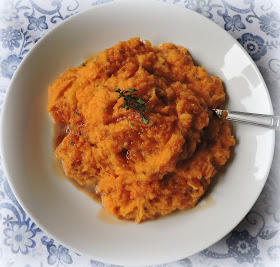
Maple Mashed Butternut Squash
prep time: 10 minscook time: 30 minstotal time: 40 mins
This is a delicious way to prepare your holiday side of Butternut squash.
ingredients:
2 lbs. butternut squash flesh (after peeling and de-seeding)
a small handful of fresh thyme stalks (about 8)
1 TBS olive oil
1 TBS olive oil
2 - 3 TBS maple syrup
3 - 4 TBS butter
salt and black pepper to taste
instructions:
Preheat the oven to 200*C/400*F/ gas mark 6. Line a
baking tray with aluminium foil. Spray lightly with non-stick cooking
spray. Slice the butternut squash into wedges. Toss together in a bowl
with the olive oil, maple syrup and season lightly with salt and pepper. Scatter
onto the baking sheet with the thyme stalks.
baking tray with aluminium foil. Spray lightly with non-stick cooking
spray. Slice the butternut squash into wedges. Toss together in a bowl
with the olive oil, maple syrup and season lightly with salt and pepper. Scatter
onto the baking sheet with the thyme stalks.
Roast
in the oven for 20 to 25 minutes, until tender and just beginning to
caramelise. Remove and tip into a bowl, discarding any stalks of
thyme. Mash together with butter to taste and the fresh thyme. Taste
and adjust seasoning as required. Keep warm until ready to serve.
in the oven for 20 to 25 minutes, until tender and just beginning to
caramelise. Remove and tip into a bowl, discarding any stalks of
thyme. Mash together with butter to taste and the fresh thyme. Taste
and adjust seasoning as required. Keep warm until ready to serve.
Note - This can be made several days in advance. Cover and refrigerate and reheat in the microwave when needed.
Created using The Recipes Generator
Another thing I really, REALLY like about dishes like this, is that you can make them up well ahead of time and just reheat them in the microwave at the last minute. It can really save a lot of time and hassle on the day you plan on serving it, especially during the holidays when you have about a bazillion other things to do! This is just so delicious! Never soggy and always perfectly cooked! This is a winner in every respect and goes very well with all kinds of roasted meats and poultry! Nom Nom!




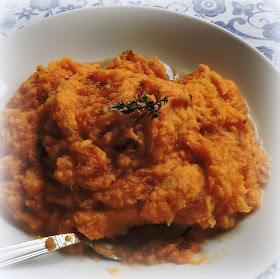

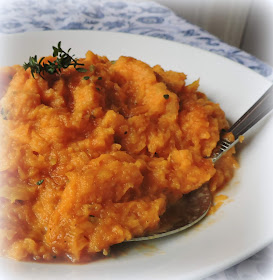

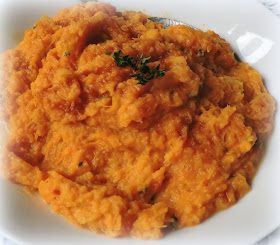
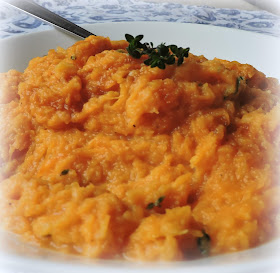
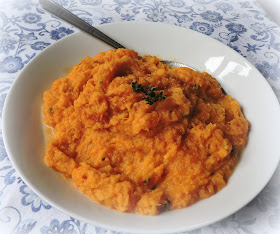
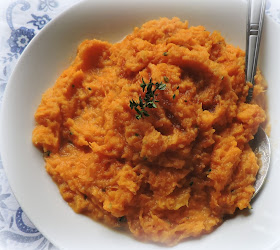

Love squash Marie!
ReplyDeleteOh me too Monique. I also love sweet potatoes and carrots! xo
DeleteSo handy this can be made ahead of time. Thank you!
ReplyDeleteWhen the holidays roll around make ahead is a great help! xoxo
Delete